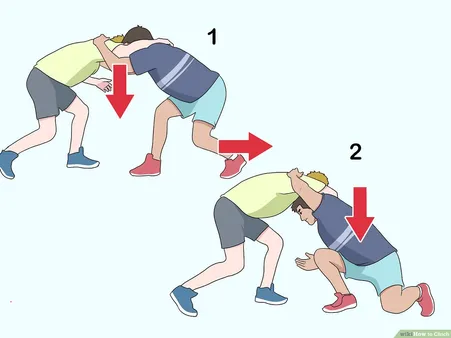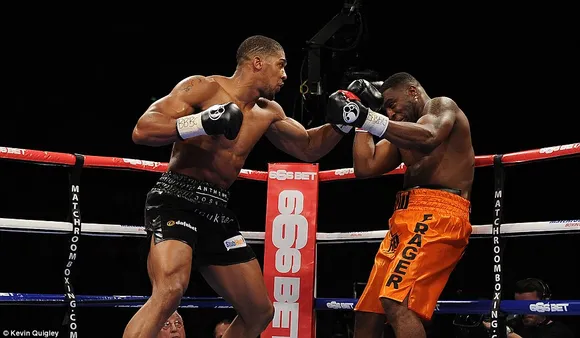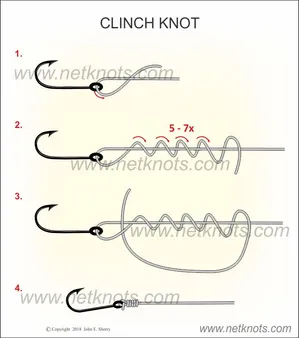Table of Contents
Unleash the power of clinching in boxing with Kizworld, your ultimate guide to mastering this essential technique. Discover the art of controlling your opponent, gaining a strategic advantage, and executing powerful moves. Whether you're a seasoned boxer or just starting out, our comprehensive guide will teach you How to do a clinch effectively, helping you elevate your skills and dominate the ring.
How to Do a Clinch - Improve Your Judo Takedown Skills
I. How to Clinch Effectively in Martial Arts
How to Clinch Effectively in Martial Arts
In the realm of martial arts, effective clinching techniques are indispensable for controlling an opponent, disrupting their rhythm, and setting up powerful strikes. Mastering the art of clinching can turn the tide of a match, allowing you to gain a tactical advantage and outmaneuver your adversary. As you delve deeper into the intricacies of clinching, you'll discover a dynamic interplay of positioning, leverage, and timing that can transform your martial arts practice.
To harness the full potential of clinching, it's essential to grasp the fundamental principles that govern its effectiveness. Firstly, establishing a strong body position is paramount, ensuring a stable base from which to execute your techniques. Secondly, maintaining close contact with your opponent prevents them from creating distance and launching attacks from afar. Thirdly, controlling your opponent's head and neck provides significant leverage and opens up opportunities for throws and takedowns.
Hip Positioning: Mastering the Clinch Crucible
Factors | Techniques | Benefits |
Lateral Movement | Stepping and pivoting | Disrupts opponent's balance & creates angles |
Forward and Backward Movement | Advancing and retreating | Controls distance & dictates pace of engagement |
Hip Rotation | Turning and shifting | Enhances leverage & generates power for throws |
In addition to strategic hip movement, maintaining proper posture and balance is vital for effective clinching. A strong and upright stance provides a solid foundation for executing powerful throws and takedowns. Simultaneously, keeping your weight distributed evenly across your feet ensures agility and quick reactions to your opponent's movements. By combining these fundamental principles with the techniques outlined above, you'll lay the groundwork for dominant clinching.
To enhance your understanding of clinching techniques and strategies, delve into our comprehensive guide on How to Do a Clinch. This in-depth resource provides step-by-step instructions, insightful tips, and common mistakes to avoid, equipping you with the necessary knowledge to master the art of clinching. Furthermore, explore our dedicated section on Martial Arts for a wealth of information on various martial arts disciplines, their histories, techniques, and training methods.
As you progress on your martial arts journey, remember that consistent practice and unwavering dedication are the keys to unlocking your full potential. Embrace the challenges of clinching and other martial arts techniques, and you'll discover a path of self-improvement, empowerment, and martial arts mastery.
II. Mastering the Fundamentals of Clinching
Mastering the Fundamentals of Clinching
Clinching is a fundamental technique in boxing that allows you to control your opponent, disrupt their rhythm, and set up your attacks. Mastering the art of clinching can significantly improve your overall boxing skills and give you a distinct advantage in the ring.
To master clinching, it is crucial to develop good technique and timing. Here are a few key tips to help you improve your clinching skills:
- Get Close: The first step to clinching is to get close to your opponent. Step forward with your non-dominant foot and bring your body close to theirs.
- Wrap Your Arms: Wrap your arms around your opponent's body, keeping your elbows tucked in and your hands close to your chest.
- Pull Your Opponent Close: Once you have your arms around your opponent, pull them close to you. This will prevent them from creating space and launching attacks.
Tip | Description |
Get Close | Step forward with your non-dominant foot and bring your body close to your opponent's. |
Wrap Your Arms | Wrap your arms around your opponent's body, keeping your elbows tucked in and your hands close to your chest. |
Pull Your Opponent Close | Once you have your arms around your opponent, pull them close to you. |
Once you have established a good clinch, you can use it to your advantage in several ways:
- Control the Pace of the Fight: By clinching, you can slow down the pace of the fight and disrupt your opponent's rhythm. This can be especially effective if you are facing a faster or more aggressive opponent.
- Set Up Attacks: Clinching can also be used to set up attacks. After you have pulled your opponent close, you can use your free hand to land punches to their head or body.
- Recover and Regain Stamina: Clinching can also be used to recover and regain stamina. By holding your opponent close, you can minimize the amount of energy you are expending and buy yourself some time to catch your breath.
To become a proficient clincher, it is important to practice regularly. You can practice clinching with a partner at your local boxing gym or with a heavy bag. With consistent practice, you will develop the skills and techniques necessary to execute effective clinches in the ring.
Related Posts:
- The Best Boxing Gloves and Wraps for Optimal Performance and Hand Protection
- Unveiling the Top Boxing Competitions and Events: A Celebration of the Sweet Science
III. Applying Clinch Techniques in Different Martial Arts
Applying Clinch Techniques in Different Martial Arts
Clinching techniques, commonly employed in grappling-based martial arts, play a crucial role in controlling the opponent, neutralizing their attacks, and creating opportunities for takedowns. Various martial arts have incorporated unique approaches to clinching with specific techniques:
- Judo and Brazilian Jiu-Jitsu: Known for their grappling focus, clinching is integral to these martial arts. Judo emphasizes gripping and throwing techniques when in a clinch, aiming to secure dominant positions and control the opponent's balance. Brazilian Jiu-Jitsu utilizes clinches to gain leverage for takedowns, utilizing joint locks and chokes from close proximity.
- Wrestling: Clinching is a fundamental aspect of wrestling where wrestlers attempt to establish control over their opponent's head and body. Double-leg takedowns, single-leg takedowns, and throws are commonly executed from clinches.
- Muay Thai: While striking is the primary focus in Muay Thai, clinch techniques are employed to set up strikes, control the opponent's movement, and defend against attacks. Muay Thai clinches often involve holding the opponent's arms, head, or neck to create openings for powerful knees and elbows.
Regardless of the martial art, effective clinching relies on mastering several key principles:
- Proper Gripping: Secure and controlled grips are essential to gain and maintain control of the opponent. Different gripping techniques exist in various martial arts, tailored to each specific discipline.
- Controlling the Head and Neck: Dominating the opponent's head and neck can significantly limit their mobility and create opportunities for takedowns or strikes. Concepts like head position, chin tucking, and head control come into play.
- Utilizing Body Positioning: The position of the body in relation to the opponent impacts the effectiveness of clinching techniques. Proper footwork, posture, and stance allow for better balance and control during grappling exchanges.
- Counter-Clinching: Anticipating and countering the opponent's clinch attempts is a vital aspect of effective clinching. Knowing how to break free from an opponent's clinch and transition into a dominant position can turn the tables.
- Transitioning to Submissions: In grappling-based martial arts, clinches often serve as the gateway to submissions. Understanding how to transition from a clinch into submission holds requires knowledge of joint locks, chokeholds, and other techniques.
In conclusion, clinching techniques are a vital part of various martial arts, encompassing a wide range of gripping, control, and takedown techniques. Mastering clinching requires dedication, practice, and an understanding of the principles that govern effective clinching. Whether it's in a grappling-based martial art like Judo or a striking-based art like Muay Thai, clinching offers a powerful and versatile tool for gaining control over the opponent.
Martial Art | Clinching Techniques |
Judo | Double-leg takedown, single-leg takedown, uchi mata, i nage |
Brazilian Jiu-Jitsu | Shoulder throw, hip throw, triangle choke, armbar |
Wrestling | Double-unders, overhooks, inside trips, outside trips |
Muay Thai | Plum clinch, neck clinch, Thai clinch |
With consistent practice, martial artists can elevate their clinching abilities, enhancing their overall grappling and striking capabilities and gaining a significant advantage in competitive matches or self-defense situations.
- Related Post: How to Master the Basic Gymnastics Skills
- Related Post: The Benefits of Gymnastics for Kids
- Related Post: How to Choose the Right Martial Art for You
- Related Post: The Best Martial Arts Equipment and Gear
IV. Training and Practice for Clinching
Training and Practice for Clinching
To master the art of clinching, it's crucial to engage in regular training and practice. Here are a few tips to enhance your clinching skills:
1. Practice with a Partner: Engage in practice sessions with a partner who is also learning or proficient in clinching. This provides an opportunity for both of you to safely practice various clinching techniques and refine your skills.
2. Focus on Technique: Pay close attention to the proper techniques involved in clinching. Work on executing each movement correctly, rather than focusing solely on strength or speed. This will help you develop good habits and prevent injuries.
3. Develop Grip Strength: Strong grip strength is essential for effective clinching. Incorporate exercises like finger curls, wrist curls, and hand squeezes into your training routine to improve your grip.
- Read more on Grip Strength Exercises and Workouts
4. Work on Your Balance: Good balance is crucial for maintaining control during clinches. Practice standing on one leg, performing balance exercises like the single-leg bridge, and incorporate agility drills into your training.
5. Sparring: Controlled sparring sessions with a partner allow you to apply your clinching techniques in a realistic setting. Start with light sparring and gradually increase the intensity as your skills improve.
6. Stay Active: Maintain a consistent training regimen to improve your overall conditioning and endurance. This will enable you to sustain your energy levels during clinching matches or fights.
Mistakes to Avoid
To avoid common mistakes that can hinder your progress in clinching, keep the following in mind:
1. Don't Rely Solely on Strength: While strength is an advantage, it's not the only factor that determines success in clinching. Focus on developing proper technique and using your strength strategically.
2. Avoid Getting Caught in a Bad Position: Be mindful of your positioning during clinches. Don't allow your opponent to trap you against the ropes or in a corner, as this can limit your options and make it difficult to escape.
Common Mistakes in Clinching | How to Avoid Them |
|---|---|
Relying too heavily on strength | Focus on technique and use strength strategically |
Getting caught in a bad position | Be aware of your positioning and avoid being trapped against the ropes or in a corner |
Not transitioning smoothly between clinching and striking | Practice transitioning quickly and seamlessly between the two |
Neglecting footwork and movement | Maintain good footwork and movement to keep your opponent off balance and create opportunities |
3. Practice Transitioning Between Clinching and Striking: Clinching often leads to striking opportunities. Practice transitioning smoothly between the two, so you can capitalize on openings and land effective punches or kicks.
4. Don't Neglect Footwork and Movement: Maintain good footwork and movement during clinches. This will keep your opponent off balance and create opportunities to escape or initiate attacks.
V. Conclusion
Clinching is an essential skill in boxing that allows fighters to control the pace of the fight, gain an advantage, and execute strategic moves. By mastering the techniques and tips outlined in this guide, you can effectively utilize clinching to your advantage in the ring. Remember to practice regularly, stay calm and focused, and avoid common mistakes to become a proficient clincher. With dedication and practice, you can elevate your boxing skills and gain control over your opponents, ultimately achieving success in the ring.